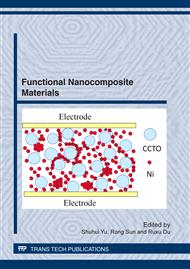p.1
p.11
p.17
p.25
p.31
p.39
p.47
p.53
Effect of Nanocomposite Additives on Corrosion Inhibition of Zn Anode in Neutral Solution
Abstract:
Effects of hexadecyl trimethyl ammonium bromide (CTAB), polyethylene glycol nanowire (NPEG) and their nanocomposite additives on corrosion inhibition of Zn in 1 mol/L ZnSO4 solution were investigated by weight-loss measurements, electrochemical tests,scanning electron microscopy and battery discharge tests. The results show that the inhibition efficiency of nanocomposite additives is 70%, which is much higher than individual inhibitors of CTAB or NPEG alone, because of the notable synergistic effect between CTAB and NPEG. While CTAB can cause a negative shift of corrosion potential of zinc, NPEG can form a very thick hydrophobic layer on the surface of zinc electrode by adsorption. Furthermore, NPEG can render part of CTAB cations to form large micelle particles along the NPEG macromolecular chains and cross-link with NPEG, and thus greatly enhance the blocking effect of the hydrophobic layer. Therefore,the corrosion inhibition efficiency of the composite additives is much higher. The battery containing 0.05% CTAB and 0.05% NPEG performs better than the batteries with individual additives, especially at high discharge current rate.
Info:
Periodical:
Pages:
17-24
Citation:
Online since:
June 2012
Authors:
Price:
Сopyright:
© 2012 Trans Tech Publications Ltd. All Rights Reserved
Share:
Citation:


